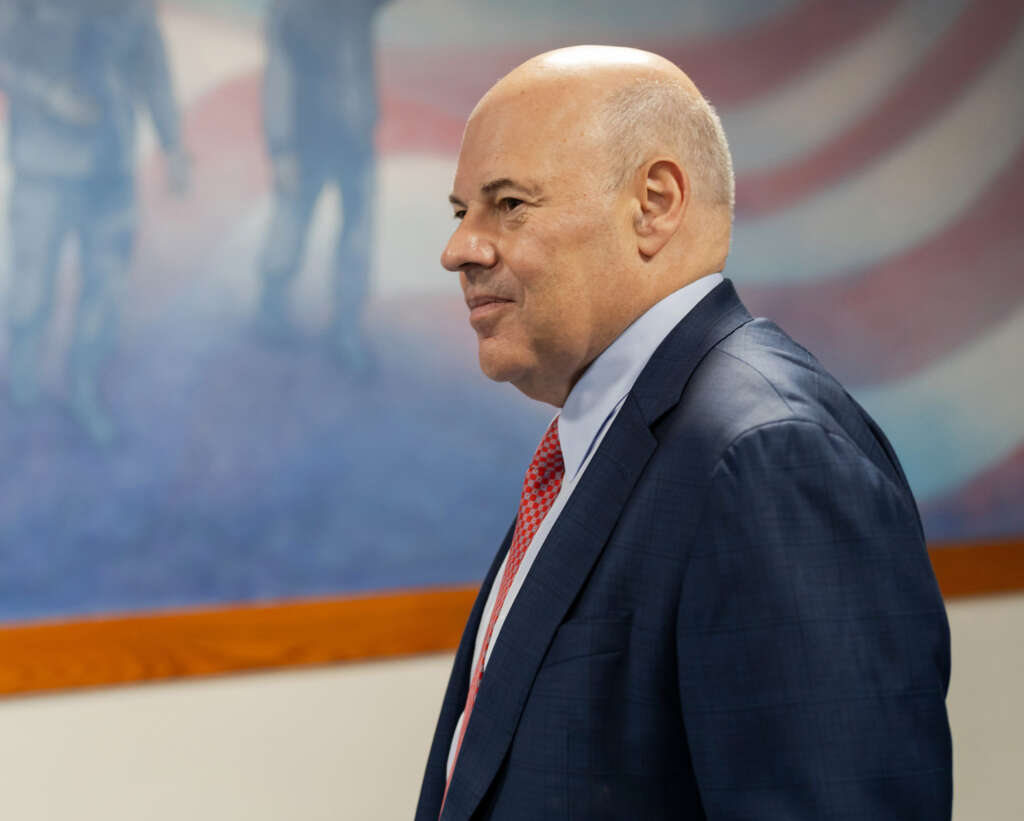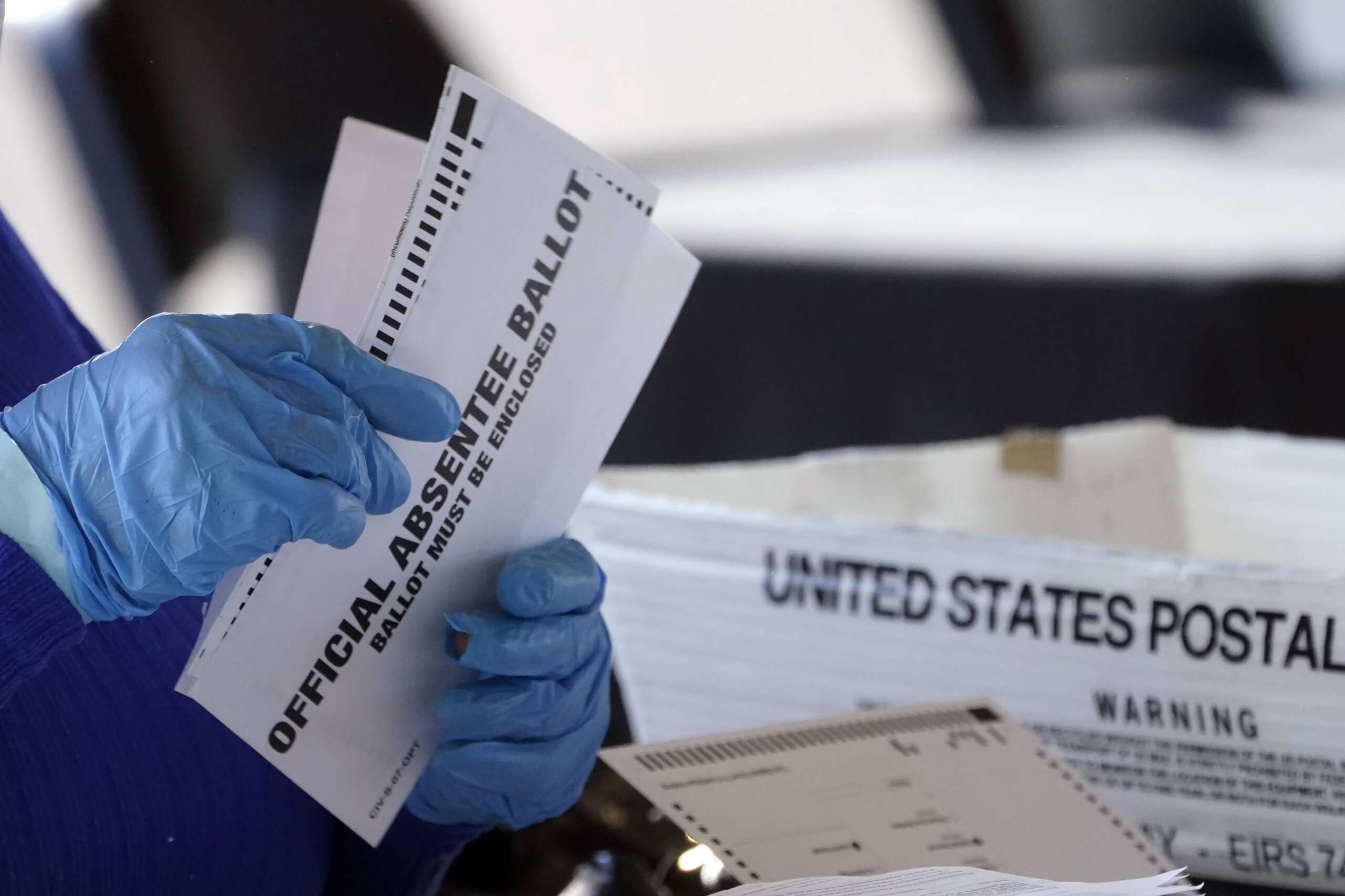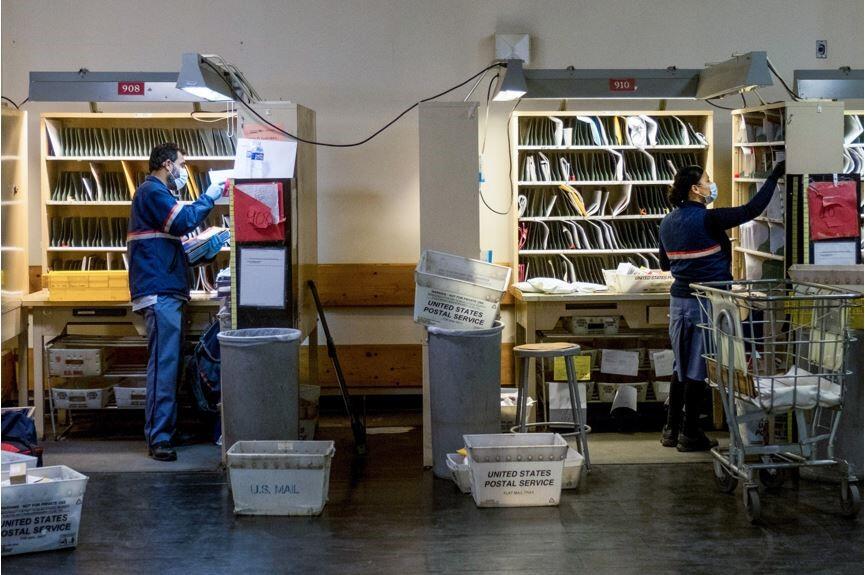Postmaster General Louis DeJoy knows his 10-year plan to put the Postal Service on firmer financial footing doesn’t suit everybody.
“If I’m the only one in town who thought the Postal Service was in crisis, then I have a different perspective. In fact, I know it was in crisis,” he said Wednesday in an interview at USPS headquarters.
DeJoy understands the plan is a tough sell for some. USPS implemented new service standards last year that slowed nearly 40% of first-class mail volume.

First-class mail prices went last fall, and they’re going up again this summer. The price of a first-class stamp was 50 cents before January 2019. By June, it’ll cost 60 cents.
“Slowing mail and raising prices, that’s what I was the postmaster general of,” DeJoy said, recalling the significant pushback he got for those elements of his “Delivering for America” plan.
But, DeJoy said USPS pricing — like so much else with the organization — has been stuck in the past, and hasn’t evolved to keep up with present-day reality.
“We hadn’t met the service standards, and we were spending tons of money trying to make them. And the fact of the matter is, in the long term, an extra day on first-class, market-dominant mail is not going to matter. It’s not going to matter 10 years from now.” DeJoy said.
If these decisions over his nearly two-year tenure have drawn critics, then DeJoy wants you to know that more unpopular decisions are coming, and that the future of the agency depends on them.
“There’s still a lot of uncomfortable things that we need to do. I’m pretty good at this stuff, but I’m not like a magician. And the team is pretty good, but we can’t undo 14 years of colossal damage that was inflicted on the organization — both by, I would say, extreme resistance that was out there from many stakeholders, in terms of us changing, and then just the lack of real fortitude to make the change,” DeJoy said.
The starkest reality is that first-class mail, the agency’s most profitable product, continues to decline year over year. DeJoy said experts in and out of USPS have studied possible ways to reverse declining mail volume, but none of those ideas have panned out.
“We have a monopoly that has been declining in value every year, becoming more of an obligation than actually a monopoly. When you think of a monopoly, it means you get to do most of what you want to do and you have enough. Who wants a monopoly that loses $10 billion a year?” DeJoy said.
But the agency, he said, is no longer worried about how long it can keep its lights on. More than a year into the “Deliver for America” reform plan, DeJoy said USPS is on track to have an “exponentially improved year,” following 15 consecutive years of net losses.
President Joe Biden earlier this month signed the Postal Service Reform Act, which will save the agency $107 billion — $57 billion now, and the rest over the next 10 years.
The legislation saves the agency money by eliminating a requirement to prefund retiree health benefits well into the future. It will also require all future postal retirees to enroll in Medicare Parts B and D.
DeJoy played an active role in matching the legislation to lawmakers, and made sure “enough of the Republican side of the Congress understood what this was about,” which included a personal commitment that the agency’s 10-year reform plan ensure the agency would still cover its costs and improve the organization.
As the bill made it through the House and Senate, DeJoy said he and the bill’s sponsors ensured the legislation, built on a tenuous compromise between Democrats, Republicans, unions and the mailing industry, didn’t go through any controversial changes that would jeopardize its chances of becoming law.
“It was important to me that anything that came with the legislation didn’t put operational restrictions on us,” he said.
Despite a sometimes contentious relationship with the Biden administration, the White House has given USPS credit for some of its recent achievements.
President Joe Biden, at the bill’s signing ceremony, said USPS “stepped up” to deliver more than 320 million COVID tests to individuals in every state and territory, as well as every military base in the world.
In the 2020 general election, 43% of the votes cast were mail-in ballots, and it took on average less than two days for ballots to get from the voters to election officials — faster than the fastest delivery time for first-class mail.
Despite the Biden administration’s focus on USPS-related issues — from mailing COVID tests to households, to its next-generation fleet, to election mail — DeJoy said he’s never spoken to President Joe Biden directly.
And despite being a long-time fundraiser for the Republican party and former President Donald Trump, DeJoy said he seldom spoke with him as well.
“I knew President Trump. I didn’t speak to him much. And when I did, it wasn’t about Postal Service initiatives. I had a relationship with the president before. We had one call, how are you doing? One call, congratulations. And that was about it. This is an independent agency, we’re supposed to have our own mission, we’re supposed to be free of any partisan things. The president really can’t tell me what to do, nor do I think they should,” DeJoy said.
If the 10-year reform plan makes some tough choices, DeJoy said the alternatives — including keeping with the status quo — are far worse.
USPS announced in 2013 that it would be forced to scale back delivery to five days a week in order to cut costs. Congress, postal unions and the public quickly shut that plan down. The postmaster general at the time, Patrick Donohue, resigned less than two years later.
Five-day delivery became a third-rail issue in USPS policy, and since the start of the COVID-19 pandemic, DeJoy said scaling back delivery days was unthinkable.
“I came in during the pandemic. You saw what we did, what we meant, and that was extremely, extremely important. If you witness that, you would never touch that,” DeJoy said.
DeJoy is quick to remind you that he doesn’t need this job. He said he doesn’t think he would have even taken the job of postmaster general, were it not for the COVID-19 pandemic.
The pandemic, he said, underscored the necessity of USPS, as well as the severity of its crisis. When he joined the agency in June 2020, the agency was months away from running out of cash.
“[I was] sitting here idle, seeing what the condition was, what was going on, and being asked to do something that’s right in my wheelhouse. I knew the Postal Service. I worked a lot with the Postal Service in the ‘90s. I was like, ‘How do I not talk to my family? How do we not do this?’ And they were like, ‘Go do it.’”
DeJoy said he initially planned to start as postmaster general in September 2020, but the USPS Board of Governors had other plans.
“We’re in a crisis, you need to get here,” DeJoy recalled them saying. “So that’s how I got here in June.”
Replacing a ‘burning and breaking’ USPS fleet
The Postal Service, under intense pressure from Congress and the Biden administration, doubled its initial order for electric vehicles as part of its next-generation delivery vehicle (NGDV) fleet.
 USPS announced last month it spent nearly $3 billion on 50,000 next-generation vehicles as part of its initial order to the vendor Oshkosh Defense. More than 10,000 vehicles as part of that initial order are electric vehicles.
USPS announced last month it spent nearly $3 billion on 50,000 next-generation vehicles as part of its initial order to the vendor Oshkosh Defense. More than 10,000 vehicles as part of that initial order are electric vehicles.
DeJoy said USPS ordered more vehicles because that’s what the agency can afford right now. He said USPS has identified more than 10,000 routes in high-density areas that are good candidates for electric vehicles.
DeJoy said he’s not against electric vehicles, but with an outdated fleet that’s “burning and breaking up every day,” he said the agency, more than anything, needs vehicles that work.
“From a green perspective, we pay attention to this stuff, to the extent that our budget enables us. It’s not my primary mission. My primary mission is to deliver to 161 million addresses and cover my costs,” he said.
DeJoy the agency has about two years until it to make its next decision on how many additional electric vehicles it will purchase from the contractor Oshkosh Defense.
USPS commits to ‘extraordinary measures’ for election mail
DeJoy said USPS will continue to carry out the “extraordinary measures” to deliver mail-in ballots to voters and election boards in future elections.
The Postal Service agreed to that much when it recently settled with plaintiffs in a lawsuit that originally challenged the agency’s ability to deliver an unprecedented number of mail-in ballots for the 2020 presidential election.
Public Citizen, the National Association for the Advancement of Colored People and its Legal Defense Fund filed the lawsuit in 2020, which in particular took issue with USPS implementing “operational changes” ahead of the general election.
Some of those changes, such as a push to reduce late and extra trucking trips between USPS processing plants and post offices, started under DeJoy’s tenure, while others, such as the removal of blue mailboxes and equipment at processing facilities, began before DeJoy took office.

The lawsuit settlement requires USPS to continue with those practices for federal elections through at least 2028, although DeJoy said the settlement doesn’t change how USPS prepares for election mail.
“The standard discussion around this is that if you give us a ballot, we’re going to deliver it,” DeJoy said.
The Biden administration is looking also to give the Postal Service $5 billion to support its mail-in voting operations over the next decade.
The administration, as part of its fiscal 2023 budget request, expects the money would fund an expansion of USPS delivery capacity in underserved areas and support for vote-by-mail, including making ballots postage-free and reducing the cost of other election-related mail for jurisdictions and voters.
The request, however, still has to make it through a lengthy congressional appropriations process, and DeJoy said it doesn’t appear as though USPS has any obvious need for the money.
“We’ll see how it plays out. Does that money go to us? Does that money go to states? We’ll see. There’s not enough details around it for me. I don’t know where I would spend $5 billion in election processes myself, but I’m very anxious to work through it. I’m a collaborator when there’s good ideas,” he said.
USPS seeks to overhaul its facilities
USPS is at a moment of reinvention, but not all those decisions need to be hard. DeJoy said there are plenty of opportunities to make USPS run more efficiently.
“We have to get $35 to $40 billion out of cost over the next 10 years. That’s 5%. I used to tell my clients, ‘You could fall out of bed and find 5%,’ so I think we can do it here. Then we’ve got to raise revenue by $25 billion, and we do that through growth in the package business and pricing,” he said.
The way DeJoy sees it, USPS needn’t look hard to find ways it can run more efficiently. DeJoy said his next big project is overhauling the agency’s sprawling network of facilities.
“We have like 900 handbooks. I collected them all. They haven’t been updated in 40 years. They teach you how to do things wrong, and we follow them religiously, because we’re kind of like a military organization: ‘I’ve got the handbook, go!’ But it’s not aligned. We have plants [where] the last time that plant someplace was managed well was in the ‘90s. You know why? Because that’s the last time that plant was suitable for the work that we had to do. It’s not about the manager, it’s about the facilities.”
An overhaul of facilities, he says, is not just necessary to right-size the organization, but to create an environment where employees actually want to work.
“We have a terrible operating environment. Our plants are old and dark, our delivery units are old and dark and crowded. So we will make gains, but until I change the work environment — which is one of my next big missions — we’re still going to have to deal with that. Who wants to come in and work there?” he said.
 USPS has also converted more than 63,000 pre-career employees to career positions, in an effort to reduce workforce turnover. DeJoy said the agency has also standardized the process for new hires to secure a career position with better pay and benefits.
USPS has also converted more than 63,000 pre-career employees to career positions, in an effort to reduce workforce turnover. DeJoy said the agency has also standardized the process for new hires to secure a career position with better pay and benefits.
While USPS is gaining momentum, and committed to spending $8 billion in capital investments this year, DeJoy said the agency still has a long way to go before its long-term problems are fully resolved.
“It’s going to take us a number of years to get through some of our toughest days. Our trajectory is not where I want to say ‘job done.’ And that’s when the job’s done, when we have a trajectory that says this is extremely viable. This can continue to happen, we have established a relevant place in the marketplace, we have the right infrastructure size and so forth, he said.
While USPS still has its share of critics, DeJoy said he’s demonstrated that he’s able to work with partners who have their own ideas of how to improve the agency.
“Everybody is on a little bit better of a conversation level, with regard to what it is we’re trying to do here. We have our own voice, they know we’re serious about it, and we’re moving forward. And I’m going to lend more ears to suggestions because they’re within a realm of being pragmatic,” he said.
